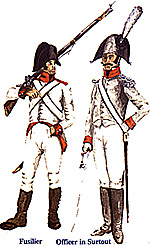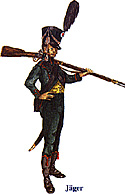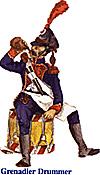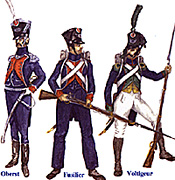The unit served in Spain from 1808 until 1813, when it deserted to the Allies. The other two battalions took part in the Russian campaign in 1812 and are sometimes called 3rd Rheinbund Regiment.
Uniforms can be divided into two distinct styles. The first was white and of Austrian pattern, the second dark-blue and in the style of French light infantry. The white uniform is illustrated by Weiland [1] who, interestingly, is also the suggested possible author of the Otto Manuscript by at least one authority. [2] In contrast to the Otto Manuscript, however, in the case of Weiland's 'Darstellung' we know, for certain, not only the identity of the artist but when and where he had sensory contact with his subjects. Unlike the 'Otto' artist, Weiland is, without doubt, a primary source. That, of course, does not make him infallible.
However, we also know that C.F. Weiland served in both the Wurttemberg and Prussian armies
and he is, therefore, an expert witness. It is also possible to corroborate his work and he can be shown to be generally reliable. In the case of his illustrations of Frankfurt infantry, these are confirmed in most details by at least one other contemporary source - a description of the dress of the battalion when it marched for Spain.
"A white jacket without lapels, red collar, cuffs and piping. The Jager
company has a green jacket cut like a hussar's, red collar, cuffs and lapels. The
grenadiers wear afur cap, the Jagers a green and black shako, the fusilier companies a
hat". [3]
It should be noted that modern renditions show a Frankfurt grenadier wearing a French style
white habit with red epaulettes, cords and plume to the fur cap, which is said to have had a white metal front plate, and a grenade device on the pouch. [5]
I can confirm none of this and I do not know what credence to place on it. It does not appear to accord with contemporary descriptions which, whilst the grenadier insignia is not impossible, depict a white uniform of decidedly old fashioned and Germanic appearance. Similarly, modern
depictions also show a French style pack and rolled grey greatcoat. This too is not confirmed by Knotel or his sources and a satchel type haversack seems more in keeping with the style of the ensemble.
The white unifonns were replaced during 1809 with blue ones, but it is not obvious if this had occurred by the Battle of Talavera on 28 July 1809. The white uniform appears to have still been in use in March 1809 because the parlous state of the battalion's dress is recorded after the Battle of Medellin on 29 March,
My illustrations of the uniforms 1809-1813, except the grenadier officer, are after Knotel again. From left to right are a grenadier officer, grenadier drummer, colonel, fusilier and voltigeur.
The grenadier officer is an extrapolation of how a junior officer might have dressed based on Knotel's illustration of a grenadier private. The men of the grenadier company had red shako cords and red epaulettes but were otherwise dressed like the officer depicted here.
The voltigeur departs from the established scheme in that the distinctives are green, piped
red. Note the yellow waistcoat. This garment was white for grenadiers and blue for fusiliers.
The pockets in the tails were of the scalloped vertical type and piped red for all companies. The shako plate bears the crowned wheel arrns of the Grand Duchy.
I have no information on colours; modern popular sources say that none were presented and Fiebig [9] in his classic work on German colours and standards does not mention any. Absence of information about such devices, however, does not mean that none existed.
Footnotes.
[1] Weiland C.F. Darstellung der Starke und
Organisation der Kaiserliche Franzosischen Armee und ihrer Allierten im Jahre 1807 und 1812. Weimar, 1812.
All illustrations © W.J. Cook 1996
Related Articles
This article appears in MagWeb (Magazine Web) on the Internet World Wide Web. The Grand Duchy provided three service battalions under its obligations as a member of the Rheinbund. The first of these was raised in September 1806. Initially of nine companies, it was later reorganized like the French model into six: voltiguer, grenadier, and four fusilier companies.
The Grand Duchy provided three service battalions under its obligations as a member of the Rheinbund. The first of these was raised in September 1806. Initially of nine companies, it was later reorganized like the French model into six: voltiguer, grenadier, and four fusilier companies.
 Knotel uses Weiland as the source for his study of the Prince Primate's infantry in 1807 [4] and shows the white uniform cut in Austrian style with
red turnbacks, red Polish cuffs, collar and shoulder straps. Weiland also shows the officer wearing a plain grey surtout type jacket, which Knotel suggests might be a form of service dress. Knotel does not attempt to reconcile the minor differences in the dress of the Jager and merely notes them. Towards the end of this first period the cockade changed from black to red
on white.
Knotel uses Weiland as the source for his study of the Prince Primate's infantry in 1807 [4] and shows the white uniform cut in Austrian style with
red turnbacks, red Polish cuffs, collar and shoulder straps. Weiland also shows the officer wearing a plain grey surtout type jacket, which Knotel suggests might be a form of service dress. Knotel does not attempt to reconcile the minor differences in the dress of the Jager and merely notes them. Towards the end of this first period the cockade changed from black to red
on white.
 My first illustrations are of the uniforms 1807-1809 and, except the grenadier, are taken from Knotel's representations of Weiland's paintings. They are from left to right, grenadier, fusilier, fusilier officer in surtout, and Jager. The grenadier is conjectural in
that I have no reliable illustration of the fur cap or the reverse of the jacket. The latter is based on Austrian precedence. I have shown trousers made of local brown Spanish cloth, which was common usage in that theatre.
My first illustrations are of the uniforms 1807-1809 and, except the grenadier, are taken from Knotel's representations of Weiland's paintings. They are from left to right, grenadier, fusilier, fusilier officer in surtout, and Jager. The grenadier is conjectural in
that I have no reliable illustration of the fur cap or the reverse of the jacket. The latter is based on Austrian precedence. I have shown trousers made of local brown Spanish cloth, which was common usage in that theatre.
"... the battalion received good shoes and new uniforms. The first were taken from the feet of dead Spaniards, trousers were made for the soldiers from their red-brown cloaks and blue cloth was requisitioned for jackets." [6]
 Is this a description of the new uniform or simply an interim measure from local resources? The uniform that replaced the white one is illustrated in the 'Augsberger Bilder' [7] and is far more sophisticated than this description appears to be. The 'Augsberger Bilder', another well known and highly regarded contemporaneous source, is the basis for two further Knotel plates on the Primate's troops. [8] The new uniform, which introduced the French style shako for all companies, does not appear to be the same as that described being procured after Medellin.
Is this a description of the new uniform or simply an interim measure from local resources? The uniform that replaced the white one is illustrated in the 'Augsberger Bilder' [7] and is far more sophisticated than this description appears to be. The 'Augsberger Bilder', another well known and highly regarded contemporaneous source, is the basis for two further Knotel plates on the Primate's troops. [8] The new uniform, which introduced the French style shako for all companies, does not appear to be the same as that described being procured after Medellin.
 The grenadier drummer is distinguished only by the broad white piping with red zigzag through it. This was repeated in trefoil knots on the thighs and down the seam of the breeches.
The grenadier drummer is distinguished only by the broad white piping with red zigzag through it. This was repeated in trefoil knots on the thighs and down the seam of the breeches.
 The commanding officer wears what is essentially a fusilier uniform with blue waistcoat
piped white. Note that the shako cords for fusiliers, when worn, were white. The fusilier is
depicted with blue trousers but these are also shown in white. Sirnilarly, breeches are shown in
both colours; gaiters are either black or white.
The commanding officer wears what is essentially a fusilier uniform with blue waistcoat
piped white. Note that the shako cords for fusiliers, when worn, were white. The fusilier is
depicted with blue trousers but these are also shown in white. Sirnilarly, breeches are shown in
both colours; gaiters are either black or white.
[2] Brown, Anne. S.K. In her translation of
Lachouque's work on the Imperial Guard 'The Anatomy of Glory'. London, 1962. pSI9. The Otto
Manuscript is the property of the Brown University, Providence, Rhode Island. Weiland's and the
anonymous Otto artist's styles are similarly childlike and, furthermore, the facial expressions of the subjects bear a remarkable resemblance.
[3] Bernay. Schicksale des Grossherzogthums
Frankfurt (I have not seen this work). Quoted by Knotel.
[4] KnotelXR. Uniformenkunde. 18 Volumes.
Rathenow, 1890-1914. Volume II, Plate 39. (Edition Friese and Lacina 1980-1995)
[5] Kannick, P. Military Uniforms in Colour.
London, 1968. Pl 228. Windrow, M and Embleton, G. Military Dress of the Peninsular War 1808- 1814. London, 1974. Pl 15. Tranie, J. Carmigniani, J,-C and de Beaufort, L. Napoleon La Campagne d'Espagne 1807-1814. Paris, 1978. Fig 17, p 90. de Beaufort's study is a rear view like Kannick's. It would appear that both used the same source so similar are the two studies, or,
perhaps, the former copied the latter. Embleton's is also a rear view but is more circumspect in that the cap is obscured by a cover.
[6] Bernay. op. cit. Quoted by Knotel.
[7] Characteristische Darstellung des
vorzuglichsten Europaischen Militars. Der kaiserlich und koniglichen privat Kunsthandlung. Augsburg, 1802- 1809. A collection of contemporary illustrations better known as the 'Augberger Bilder'.
[8] Uniformenkunde. op. cit. Volume II, plate
40 and Volume VIII, plate 31.
[9] Fiebig, E. Unsterbliche Treue - Das
Heldenleid der Fahnen und Standarten des deutchen Heeres. Berlin, 1936.
Grenadier Company: Grand Duchy of Frankfurt an Main 1806 (Issue 29)
Dispatches Letter: More on the Frankfurters (Issue 29)
Dispatches Letter: The Frankfurt Politic (Issue 30)
Back to Table of Contents -- First Empire #28
© Copyright 1996 by First Empire.
Other military history articles and gaming articles are available at http://www.magweb.com